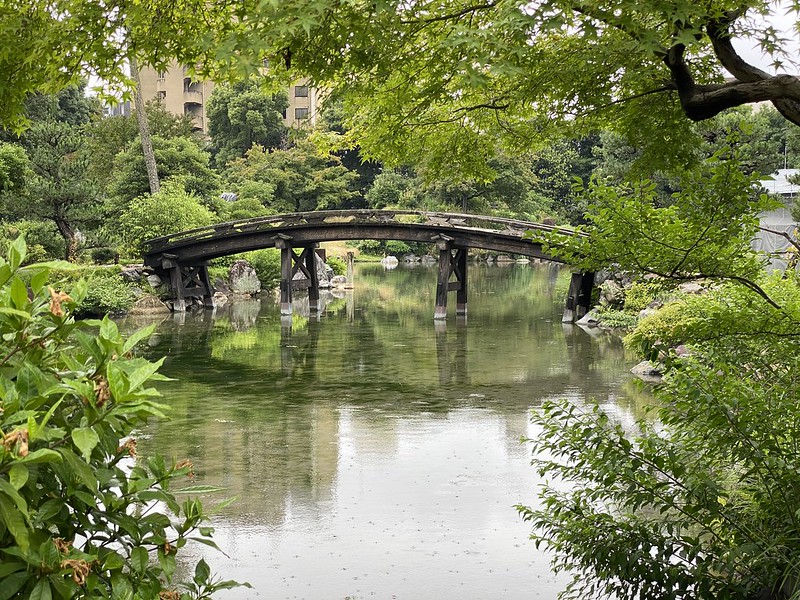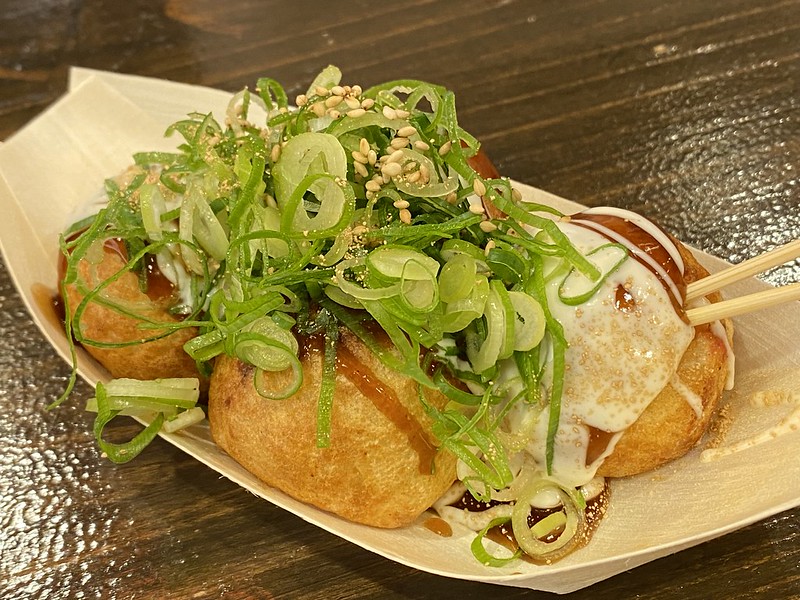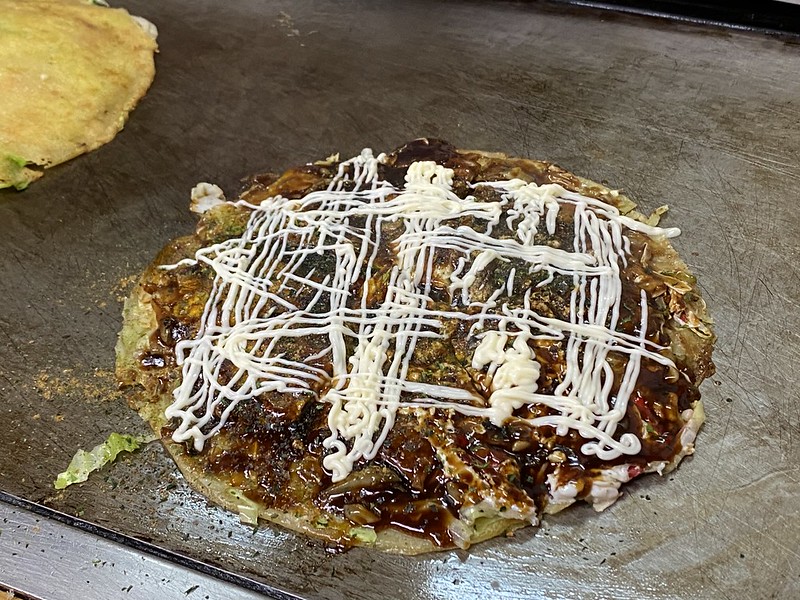We slept in a bit this morning, not getting up until close to 08:00. We decided to start the day by exploring the nearby Shosei-en Garden, which is only a couple of short blocks from our hotel. But first my wife wanted some coffee, so I searched and found a cafe called murmur coffee not far away where she got a take-away. She said it was drip style coffee rather than what she was used to, but it was still good.
The garden cost ¥500 each to enter, and the woman at the counter gave me a very nicely designed glossy brochure with map, which she very deliberately said I could keep, and was not allowed to give it back. We followed the suggested walking route around the garden, exploring the various corners with tea houses, pavilions, and wooden and stone bridges over the pond and streams. We saw sparrows, mallards, crows, and some grey herons, which are impressively large birds.
It didn’t take too long to walk around the garden, so we headed back to the hotel since it was nearby for a few minutes to put on some sunscreen and use the bathroom before heading out again.
We walked north, choosing random small streets to avoid the larger roads. Our goal was Nishiki Market, which is famous as the evolution of a traditional market street. It runs for several blocks and has a roof covering the street, which is pedestrians only and was a bit crowded with people – mostly tourists.
It was a good mix of shops selling wares, ones selling fresh seafood, meat, or vegetables for home preparation, stalls selling food ready to eat, and restaurants. We browsed along everything and stopped in several places for bites to eat. The first stop was a place selling very large rice crackers and also skiers of what looked like meat but apparently was made of rice, topped with various things. We got a couple fo the rice crackers, a “five pieces” one and a sea lettuce one. They came hot, and we ate them sitting in the shop. There were frequent reminders over a PA system that eating while walking was prohibited, and all food must be eaten in or next to the shop you buy it from. Next I stopped at a place to get some takoyaki. They wouldn’t let my wife sit with me inside while I ate unless she also bought some food, so she explored outside a bit instead.
We grabbed a few other miscellaneous snacks to eat, filling up on bites that came together to make quite a respectable lunch. We also stopped to browse in several of the shops, including the Aritsugu knife shop, founded in 1560, and now operated by the 18th generation descendant of the original founder. There were also shops selling nice looking pottery
We reached the end of the Nishiki Market and continued on east towards our next destination. The next stop was Hanamikoji Street, which is a preserved historical street and district with old style houses, many of them converted to shops or restaurants, although many are also still used as private residences. Some of the buildings look old and well preserved, while others have clearly been recently renovated as the wood looked very new, but in the same old style in keeping with the historic nature of the area. One interesting thing was there were large signs placed frequently, warning people that Hanamikoji was a private street and that photography is forbidden. The signs say that surveillance cameras are in use, and there is a ¥10,000 fine for taking photographs without a permit. It was a bit of a shame, as it was very photogenic, but I didn’t want to risk having security guards come racing out and trying to issue a fine, so I withheld from taking any photos, although I saw a handful of the other tourists sneaking photos here and there.
Along this street we stopped in a shop where we had to remove shoes to enter. They had some amazing pottery pieces in there – amazing and expensive. Some tiny tea cups were around ¥5000 ($50), and there were bowls for around ¥20,000 ($200) or more, as well as some more decorative pieces that went up to ¥200,000 ($2000). The iron glaze on some of them was amazing, giving them a sparkling metallic glitter appearance, in various attractive colours. We also stopped in a shop that sold tenugui printed with a very large range of art designs in more or less traditional styles. Some of these were very attractive and would make excellent wall hangings or framed pictures, but we didn’t get any. We did get some cotton handkerchiefs form another shop, printed in more attractive designs with gold highlights. My wife chose three of these for a special price for the three.
At the south end of Hanamikoji Street entered the Kennin-ji Zen Buddhist temple. This is a sizeable temple and a significant one in Zen Buddhism. There were some parts of the complex that were fenced off with low fences and other people were walking around inside, but we figured they must have paid to get in there via one of the buildings which we hadn’t bothered to go in because of the entry fee. But we could still see everything from the outside area. We walked out an exit to the south to continue back to our hotel.
The day had been mostly overcast and very humid, but not rainy. It was warm though, and we used the opportunity to cool off and rest on our hotel room before seeking dinner. I looked for some okonomiyaki restaurants with vegetarian options, and found four within walking distance. Reading their reviews made me want to try Yamamoto Mambo first. When we arrived there, it looked good, but was very busy and a man behind the cooking counter said they were booked out and it would be a “long long” wait for a table.
So we headed to the next place, an intriguing possibility with a very high Google review rating, but based on only 15 reviews, compared to the 500+ for all of the other options I’d found. It was called Aikochan, and one reviewer said it seemed to be operated by an old couple out of the lower floor of their old house, but was well worth the visit. As we walked over towards it, the shops petered out, and the pedestrian traffic as well, until we were walking through an almost derelict old residential neighbourhood. Here we found the old two-storey house with a red lantern out the front. A middle-aged woman was on her phone outside, but came over to usher us in as we walked towards the door. I asked “okonomiyaki desu ka?” and she confirmed it was the right place.
Entering, we found a tiny room with a counter with two large hotplates facing four barstools. There were two small tables, one with four seats and the other with two, four a total seating capacity of ten people, although the room would be very cramped with ten in it. As we entered, we were the only customers, though. Behind the hotplates was an older woman (perhaps the other one’s mother?). Neither spoke more than a few words of English, so my wife got out her vegetarian card written in Japanese to show them. They understood, and asked a few questions to confirm that she could not eat squid either, and we also managed to convey that I was fine with anything on the menu. They went through a list of various meat options and I chose pork. I ordered an Asahi beer from the fridge and my wife didn’t want anything so they gave her some iced tea.
The old woman began cooking the okonomiyaki for us, by laying down a thin layer of batter. After letting this cook briefly she topped it with chopped raw cabbage, spring onions, some pickled ginger, and something that looked like rice bubbles. Mine then received a layer of thinly sliced pork strips. This cooked for a while, then the woman poured some more batter on top, and flipped them with two spatulas. After cooking the other side for a few minutes, she took out two eggs, checking that my wife was okay with egg (so I’m not sure what was in the original batter). She cracked an egg onto the hotplate and then picked up my okonomiyaki and dropped it on top of the egg, then repeated the process with the other one. At this point she asked us if we wanted spicy or mild. I said spicy, and my wife said a little bit spicy. After a minute or so she flipped them over again and spread two different sauces on with large brushes. I think the first was the spicy one. Then she topped with powdered kelp, and powdered bonito for me, and then mayonnaise. She cut the okonomiyaki into eight wedges and served up the first onto a small plate for us to eat with chopsticks, leaving a small spatula for us to help ourselves to the remaining pieces from the hotplate, which kept them warm.
It was delicious, really good. After eating a few pieces each, four young men came in and took the table of four, squashing behind us. They seemed to speak Japanese, but still apparently had some difficulty figuring out the menu options. The lady pushed our remaining pieces to the edge of the hotplate and prepared the middle to begin cooking their okonomiyaki, which also had noodles on them. When we finished eating and got up to pay, the old woman also gave us a packet of 7-Eleven pancakes with maple syrup flavour, presumably as some sort of dessert. This seemed very generous, especially when the price for the entire meal, including a beer, came to just ¥1550 (about A$16)! What an absolutely amazing experience.
We walked back the short few blocks home to the hotel, stopping at a 7-Eleven on the way to buy some rice balls for me for tomorrow’s breakfast. I also grabbed a chocolate ice cream for dessert. My wife wanted to save the pancakes for is to share at breakfast too.
Back at the hotel, it was early enough for us to do some laundry, using the hotel’s coin-operated machines. We washed our things, which should give us enough clean clothes to last the rest of our trip.







“We browsed along everything and stopped in several places for bites to eat. The first stop was a place selling very large rice crackers and also skiers of what looked like meat but apparently was made of rice, topped with various things. ”
I know it’s a typo, but I like the idea of their selling dolls of people skiing, made of molded (sushi?) rice.